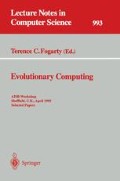Abstract
A genetic recombination framework is presented within which both the unit of inheritance of genetic material from a parent, and the number of parents involved in the creation of a new individual are potentially learnt through the evolution of competing subpopulations representing different strategies.
At the heart of the framework is a recombination mechanism whereby a newly created member of the population may be the result of the conjunction of genetic material from any number of parents, from a low of one up to a maximum limited by the number of genes in the individual chromosome. This is achieved by the use of a representation with genotypically encoded “links” between adjacent genes, which are respected during recombination. Initially the system contains subpopulations with differing degrees of linkage, and these link bits are subject to mutation. Thus the framework encompasses a variety of strategies from population based random mutation hill-climbing through to the simultaneous parallel optimisation of each locus individually cf. Syswerda's Simulated Crossover, and the competition between subpopulations representing these strategies allows the amount and type of recombination to adapt as the search progresses.
The performance of the operator is demonstrated by comparisons with other common recombination strategies over a range of function optimisation problems designed to illustrate a variety of degrees of epistasis and deception. The flexibility of the operator in terms of various parameter settings is investigated, and an analysis is given of the different strategies adopted by the framework to solve different classes of problems.
Preview
Unable to display preview. Download preview PDF.
References
J.D. Schaffer & L.J.Eshelman. 1991 “On Crossover as an Evolutionarily Viable Strategy”. pp 61–68.,R.Belew & L.Booker (eds) “Proceedings of the Fourth International Conference on Genetic Algorithms”, Morgan Kaufman.
T.C.Fogarty 1989 “Varying the Probability of Mutation in Genetic Algorithms” pp 104–109 J.D.Schaffer (ed) “Proceedings of the Third International Conference on Genetic Algorithms” Morgan Kaufman
T.Back. 1991 “Self Adaptation in Genetic Algorithms”, pp263–271 in F.Varela & P.Bourgine (eds) 1992. “Towards a Practice of Autonomous Systems: Proceedings of the First European Conference on Artificial Life” MIT Press
T.Bäck 1993. “Optimal Mutation Rates in Genetic Search”. pp 2–8 in S.Forrest (ed) “Proceedings of the Fifth International Conference on Genetic Algorithms”, Morgan Kaufman.
J.D.Schaffer &A.Morishima 1987 “An Adaptive Crossover Distribution Mechanism for Genetic Algorithms” p36–40 in J.Grefenstette (ed). ”Proceedings of the Second International Conference on Genetic Algorithms”. Lawrence Erlbaum.
T.White & F.Oppacher 1994 “Adaptive crossover Using Automata” in [18] pp 229–238
L.Davis 1989. “Adapting Operator Probabilities in Genetic Algorithms” pp 61–69 in J.D.Schaffer (ed) “Proceedings of the Third International Conference on Genetic Algorithms” Morgan Kaufman.
D.C.Mattfeld. H.Kopfer & C.Bierwirth 1994 “Control of Parallel Population Dynamics by Social-like Behaviour of GA-Individuals” in [18] pp 16–25
M.Sebag & M.Schoenauer 1994 “Controlling Crossover through Inductive Learning” in [18] pp 209–218
G.Syswerda 1992 “Simulated Crossover in Genetic Algorithms”. pp239–255. L.Darrel Whitley (ed) 1993, “Foundations of Genetic Algorithms 2”. Morgan Kaufmann.
L.Eshelman & J.D.Schaffer 1993 “Crossover's Niche”. pp9–14 S.Forrest (ed) “Proceedings of the Fifth International Conference on Genetic Algorithms”, Morgan Kaufman.
A.E.Eiben, P-E Raue & Zs. Ruttkay 1994. “Genetic Algorithms with multi-parent recombination” in [18] pp 78–87
M.A.Potter & K.A.DeJong 1994 “A Cooperative Coevolutionary Approach to function optimisation” in [18] pp 248–257
J.E.Smith & T.C.Fogarty 1995. “A Linkage Evolving Genetic Operator” Technical Report 95–01, Evolutionary Computing Group, University of the West of England.
J.E.Baker 1987. “Reducing Bias & Inefficiency in the Selection Algorithm” p14–21. J.Grefenstette (ed) “Proceedings of the Second International Conference on Genetic Algorithms”. Lawrence Erlbaum.
J.Maynard Smith 1978. “The Evolution of Sex” p 36. Cambridge University Press.
S.Forrest & M. Mitchell 1992 “Relative Building Block Fitness and the Building Block Hypothesis” pp 109–126 in L.Darrel Whitley (ed) 1993, “Foundations of Genetic Algorithms 2”. Morgan Kaufmann.
Y. Davidor H-P Schweffel & R.Manner (eds) 1994 “Parallel Problem Solving From Nature III Proceedings of Int'n'l Conference on Evolutionary Computation” Springer Verlag
Author information
Authors and Affiliations
Editor information
Rights and permissions
Copyright information
© 1995 Springer-Verlag Berlin Heidelberg
About this paper
Cite this paper
Smith, J., Fogarty, T.C. (1995). An adaptive poly-parental recombination strategy. In: Fogarty, T.C. (eds) Evolutionary Computing. AISB EC 1995. Lecture Notes in Computer Science, vol 993. Springer, Berlin, Heidelberg. https://doi.org/10.1007/3-540-60469-3_24
Download citation
DOI: https://doi.org/10.1007/3-540-60469-3_24
Published:
Publisher Name: Springer, Berlin, Heidelberg
Print ISBN: 978-3-540-60469-3
Online ISBN: 978-3-540-47515-6
eBook Packages: Springer Book Archive

